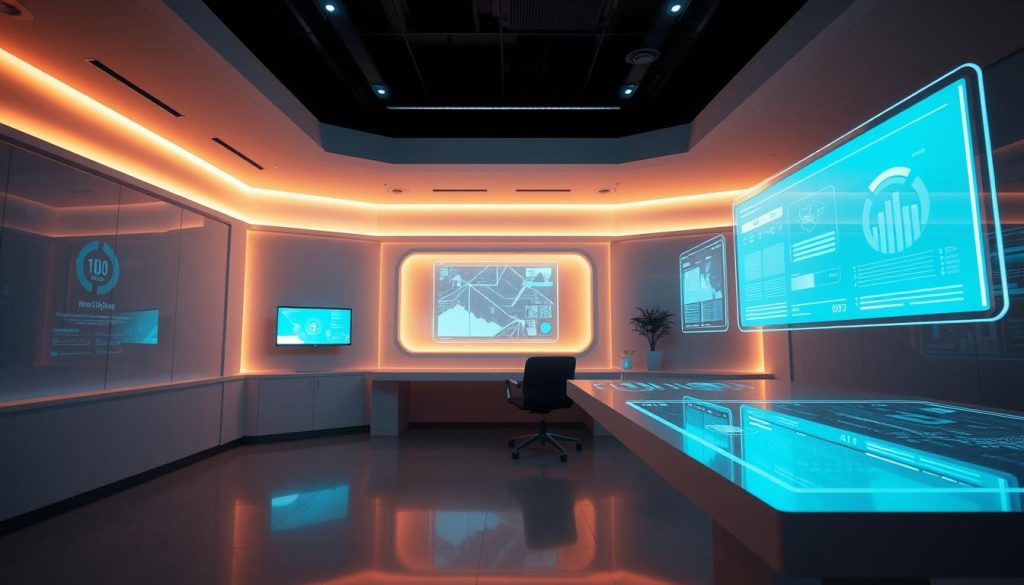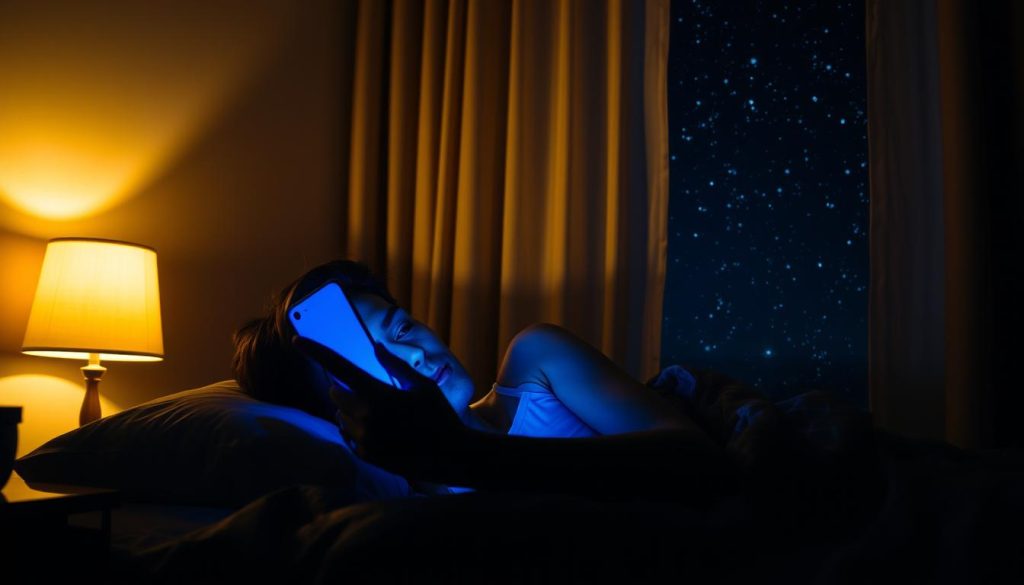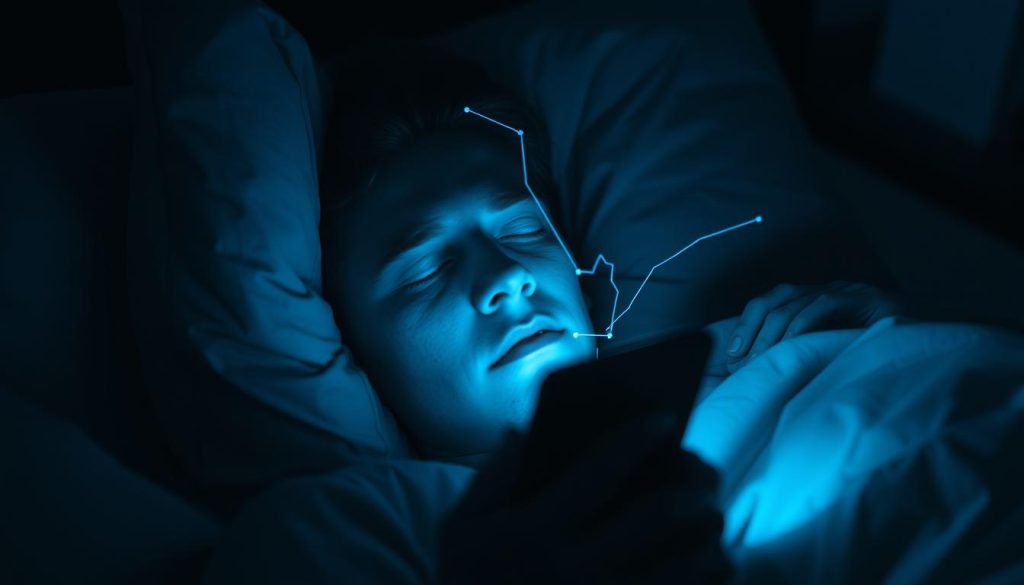In today’s fast-paced digital era, using technology is a big part of our lives. But, this can affect our natural biological clock, or circadian rhythm. This rhythm controls important bodily functions like sleep and overall health.
It’s key to understand how technology and our circadian rhythm interact. By syncing our digital habits with our natural clocks, we can improve sleep, increase productivity, and feel better overall.
The Importance of Circadian Rhythm
The circadian rhythm, or our internal body clock, is key to our sleep-wake cycles and body functions. It makes sure our body works best by following the day-night cycle. Knowing its role can boost our mood, brain power, and metabolism.
Defining Circadian Rhythm
The circadian rhythm is a natural clock that controls our body’s changes over 24 hours. It affects our sleep, hormone release, eating, and body temperature. Keeping a regular circadian rhythm helps us stay healthy and in sync with the world.
Role in Health and Well-being
Our health is linked to our circadian rhythm’s regularity. Disruptions can cause sleep problems, mood swings, and brain issues. Staying consistent in sleep and listening to our body clock is vital for health. Understanding the link between our rhythms and habits can improve our lifestyle and well-being.
Understanding Technology’s Impact
In today’s world, technology touches every part of our lives. It changes how we do things every day. Smartphones, tablets, and computers have made our lives easier, changing how we work, talk, and have fun.

How Technology Shapes Our Lives
Digital devices have changed how we handle tasks and connect with others. They make talking fast, work better, and give us lots of info. But, being always connected and looking at screens a lot can be hard on our bodies.
Benefits and Drawbacks of Digital Devices
Digital tools have many good points, like making it easy to stay in touch and find info. But, they can also make us spend too much time on screens. This can mess up our sleep and health. It’s important to know both sides of using technology.
| Aspect | Benefits | Drawbacks |
|---|---|---|
| Communication | Instant connectivity, global reach | Overreliance on digital interactions, less face-to-face time |
| Work Efficiency | Enhanced productivity, remote work capabilities | Blurred work-life boundaries, potential burnout |
| Information Access | Vast resources, easy knowledge acquisition | Information overload, credibility concerns |
Sleep Patterns and Digital Habits
It’s important to know how digital use affects our sleep. Using devices before bed can mess with our sleep and health. By looking into how sleep and digital habits connect, we can find ways to sleep better.
The Connection Between Sleep and Digital Habits
Studies show a strong link between screen use before bed and bad sleep. The blue light from screens can stop our body from making melatonin, the sleep hormone. This makes it harder to fall asleep and lowers sleep quality, making us tired during the day.
Improving Sleep through Mindful Tech Usage
Using technology wisely can help us sleep better. Cutting down on screen time before bed and using night mode can help. Also, having a regular bedtime routine and relaxing activities before bed can make for a better sleep environment.
Changing our bedtime habits can balance digital use with good sleep. This leads to better rest and overall health.
| Bedtime Habit | Impact on Sleep Quality |
|---|---|
| High Screen Time before Bed | Reduced melatonin production, delayed sleep onset, lower sleep quality |
| Limited Screen Time before Bed | Improved sleep onset, higher sleep quality, increased daytime alertness |
| Using Night Mode on Devices | Less blue light exposure, better sleep quality |
| Engaging in Relaxing Activities before Bed | Lower stress levels, faster sleep onset, deeper sleep |
The Role of Blue Light Exposure
Electronic screens have changed our lives a lot. It’s important to know how blue light affects us. Blue light can mess with our sleep and cause eye problems.
What is Blue Light?
Blue light is a type of high-energy light we see. It’s different from red and yellow light. It’s everywhere in our digital world.
Devices like phones and computers give off a lot of blue light. This light can harm our eyes deeply.
Blue Light and Melatonin Production
Blue light before bed messes with our sleep hormone, melatonin. This makes it hard to fall asleep and affects our sleep quality. It also messes with our body’s natural clock.
To fix this, try to use screens less before bed. Use blue light filters or glasses. These steps can help your eyes and sleep better.
Managing Technology Usage Before Bed
Creating a bedtime routine is key to better sleep. Make your bedroom a tech-free zone and set a digital curfew. Also, use relaxation techniques to get ready for sleep.
Creating a Bedtime Routine
Having a regular bedtime routine tells your body it’s time to relax. You might read a book, practice relaxation, or take a warm bath. These activities calm you down and prepare you for sleep.
Setting Boundaries with Digital Devices
Turn off all screens at least an hour before bed to sleep better. Make your bedroom a tech-free area. This avoids blue light and helps you relax, improving your sleep.
Artificial Lighting and Its Effects
Artificial lighting has changed our world a lot. But, it also brings challenges like disrupting our natural rhythms. LED lights and more light pollution can mess with our body’s natural clock.
Being exposed to artificial light at night can change how we sleep. This can lead to long-term sleep problems. It’s key to know how night lighting affects us.
Light pollution is a big issue. It’s not just about seeing the stars. It also harms our health. Too much artificial light at night can stop our body from making melatonin, which helps us sleep.
People who get too much artificial light at night might have trouble sleeping. This can cause sleep disorders. These disorders can really hurt our health and happiness.

| Type of Lighting | Impact on Circadian Rhythm | Contributing Factors |
|---|---|---|
| LED Lighting | High circadian disruption | Blue light emission |
| Fluorescent Lighting | Moderate circadian disruption | Intensity and exposure duration |
| Incandescent Lighting | Low circadian disruption | Warmer light spectrum |
| Street Lighting | Variable circadian disruption | Light pollution and night-time exposure |
In short, artificial lighting is a big part of our lives. But, we need to understand its effects on our sleep. This is key to keeping our health in check.
Smart Home Solutions for Better Sleep
Smart technology is changing how we live, including our sleep. Now, smart home solutions help improve sleep quality. They work with our natural sleep cycles.
Innovative Technologies for Sleep Improvement
Smart tech can make your sleep better. Smart mattresses adjust to your body for comfort. Sleep tracking apps give tips to sleep better.
Automated systems change how we sleep. Devices like the Philips SmartSleep Headband help you sleep deeper. They help your body get the rest it needs.
Smart Lighting Systems
Smart lights help you sleep by mimicking daylight. Brands like Philips Hue and LIFX adjust light to match day and night. This helps your body stay in sync with nature.
Using smart tech for sleep can make a big difference. It helps you sleep better and feel healthier. As we use more sleep tech, our sleep and health will keep getting better.
Disruption of Circadian Rhythm by Technology
In our digital world, technology’s impact on our sleep is huge. It often causes sleep problems and even insomnia, hurting our health.
Common Disruptions
Technology can disrupt our sleep in many ways. For example, using devices at night can wake us up. The blue light from screens stops our body from making melatonin, which helps us sleep.
This messes with our natural sleep cycle. It makes it hard to sleep well.
Strategies to Mitigate Negative Effects
We need to find ways to fight back against technology’s impact. Reducing screen time in the evening is a good start. It helps avoid insomnia caused by tech.
Setting a digital bedtime can also help keep our sleep cycle healthy. Using apps that reduce blue light can also improve our sleep quality.

| Disruption | Effect | Mitigation Strategy |
|---|---|---|
| Blue Light Exposure | Reduced Melatonin Production | Use Blue Light Filters |
| Nocturnal Device Usage | Sleep Disturbances | Implement Digital Curfew |
| Tech-Induced Insomnia | Poor Sleep Quality | Adopt Screen-Free Routine Before Bed |
Tips for Harmonizing Circadian Rhythm and Technology
It’s tough to find a balance between our natural rhythms and tech. But it’s key for our health. By using tech wisely and making sleep-friendly habits, we can rest well and stay healthy. Here are some tips to help you find that balance.
Optimal Tech-Use Practices
Going tech-free can really help your sleep and health. Cutting down on screen time before bed lets your body make melatonin. This helps you sleep better. Here are some good tech habits:
- Set a tech-free time at least an hour before bed.
- Use blue light filters on your devices to cut down on exposure.
- Do things that don’t involve screens, like reading or mindfulness.
Balancing Screen Time and Rest
It’s important to find a balance between tech use and rest. Taking breaks and relaxing can improve your sleep. Here are ways to balance tech and rest:
- Take regular breaks from screens during the day.
- Do physical activities to balance out screen time.
- Have a consistent bedtime routine to signal it’s time to sleep.
To harmonize your natural rhythm with tech, think carefully about your digital habits. By detoxing from tech, using it mindfully, and focusing on sleep, you can rest well and live a balanced life.
Future Trends in Circadian Rhythm and Technology
As we move forward, new technologies are changing how we manage our sleep. Wearable devices and smart homes are key in this area. They help us track and improve our sleep patterns.
Companies like Apple and Fitbit are working hard to improve their tech. They give us real-time data on our sleep and rhythms. This helps us make better choices for a good night’s sleep.
New tech is also helping in circadian research. Light therapy devices and smart lights are changing how we feel during the day and night. For example, Philips Hue lights mimic daylight, helping us sleep better.
Future research will help us understand how tech affects our sleep and health. We’ll see more tech that fits into our daily lives. This could lead to better sleep and a healthier life.

